The Blue Dolphin Cichlid, scientifically known as Cyrtocara moorii, is a fascinating addition to any freshwater aquarium. This mid-dwelling fish belongs to the Cichlidae family and shares its home with other African cichlids like the Malawi Mbuna and the African Peacock Cichlid. With its striking blue hues, it’s a visual delight that’s sure to capture your attention.
Table of Contents
If you’re wondering about the rarity of the Blue Dolphin Cichlid, you’ll be pleased to know it’s not particularly rare but is considered a specialty among cichlid enthusiasts. This makes it a great choice for both novice and experienced aquarists. Its vibrant blue coloration can vary in intensity, depending on factors like diet and water conditions, although there are no officially recognized variants.
Native to Lake Malawi in Africa, the Blue Dolphin Cichlid thrives in specific water conditions. The optimal water parameters for this fish are a pH level of 7.7-8.6 and a temperature range of 75-81°F. As for its diet, it’s omnivorous but leans more towards a carnivorous diet, enjoying a mix of live food, pellets, and some plant matter. Generally, it has a peaceful temperament but can become territorial, especially during breeding seasons.
When it comes to statistics, adult Blue Dolphin Cichlids can grow up to 8-10 inches and have a lifespan of 8-10 years. They are sensitive to water conditions and require a well-filtered tank to thrive. Fun fact: despite their name, they’re not related to dolphins at all! They can even recognize their owners and may “dance” when they see them, adding a unique charm to your aquarium.
The history of the Blue Dolphin Cichlid dates back to its first scientific description in 1902. It gained popularity as an aquarium fish in the late 20th century and has been a favorite among cichlid enthusiasts ever since. Another interesting tidbit is that they are mouthbrooders. The female carries the fertilized eggs in her mouth until they hatch, showcasing a unique aspect of their behavior.
In summary, the Blue Dolphin Cichlid is a captivating fish that offers both aesthetic appeal and interesting behavior. Its moderate level of care requirement and compatibility with other African cichlids make it a rewarding choice for any aquarist.
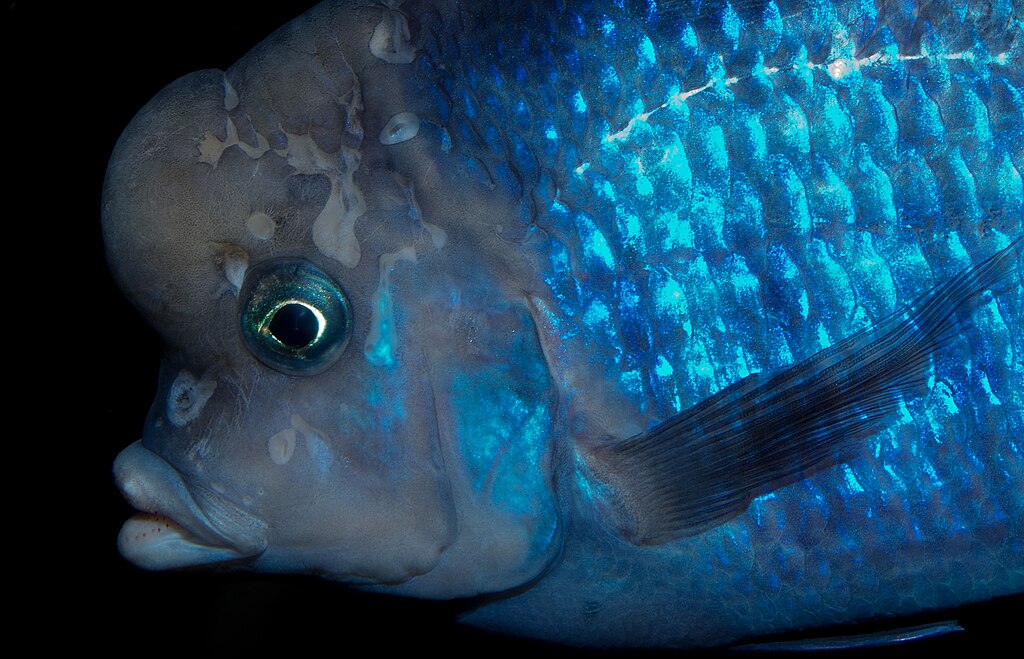
Key Information
The coloration of the Blue Dolphin Cichlid is truly captivating and stands out as one of its most remarkable features. While there are no officially recognized variants, the intensity of its blue hues can differ based on factors like diet and water conditions. This adds an extra layer of intrigue to an already fascinating species. Now, let’s delve into the various aspects of this remarkable fish in the table below.
| Family | Cichlidae |
| Price | $20-$40 depending on size and coloration |
| Common Names | Blue Dolphin Cichlid, Malawi Blue Dolphin, Humphead Cichlid |
| Variants | No officially recognized variants, but color intensity can differ |
| Ideal Tank Size | Minimum 55 gallons |
| Water Parameters | pH 7.7-8.6, temperature 75-81°F |
| Lifespan | 8-10 years |
| Full Size | 8-10 inches |
| Natural Environment | Lake Malawi, Africa |
| Behavior | Generally peaceful but can be territorial, especially during breeding |
| Habitat Preference | Mid-water dweller |
| Aquarium Decoration | Rocks, caves, and some plants for hiding |
| Ideal Tank Mates | Other African cichlids, catfish, larger tetras |
| Fish to Avoid | Small, aggressive fish and those that can fit in its mouth |
| Best Foods/Diet | Omnivorous; prefers live food, pellets, and some plant matter |
| Disease | Susceptible to common freshwater diseases like Ich if water conditions are poor |
| Sex-Switch | No known sex-switching behavior |
| Gender Differences | Males are generally more colorful and have a more pronounced hump on their head |
| Care Level | Moderate |
| Breeding Level | Moderate; mouthbrooders |
Ideal Tank Mates
When selecting ideal tank mates for the Blue Dolphin Cichlid (Cyrtocara moorii), it is essential to consider the compatibility of each species in terms of size, temperament, and environmental requirements. The Blue Dolphin Cichlid is a peaceful and sociable fish that thrives in a community tank setting with other similarly sized, non-aggressive species.
To create a harmonious and visually appealing aquarium, it is crucial to choose tank mates that complement the Blue Dolphin Cichlid’s behavior and aesthetics. By carefully selecting compatible species, you can establish a well-balanced ecosystem that promotes the health and well-being of all inhabitants.
Here are 10 ideal tank mates for the Blue Dolphin Cichlid, along with detailed information about each species:
1. Yellow Lab Cichlid (Labidochromis caeruleus)
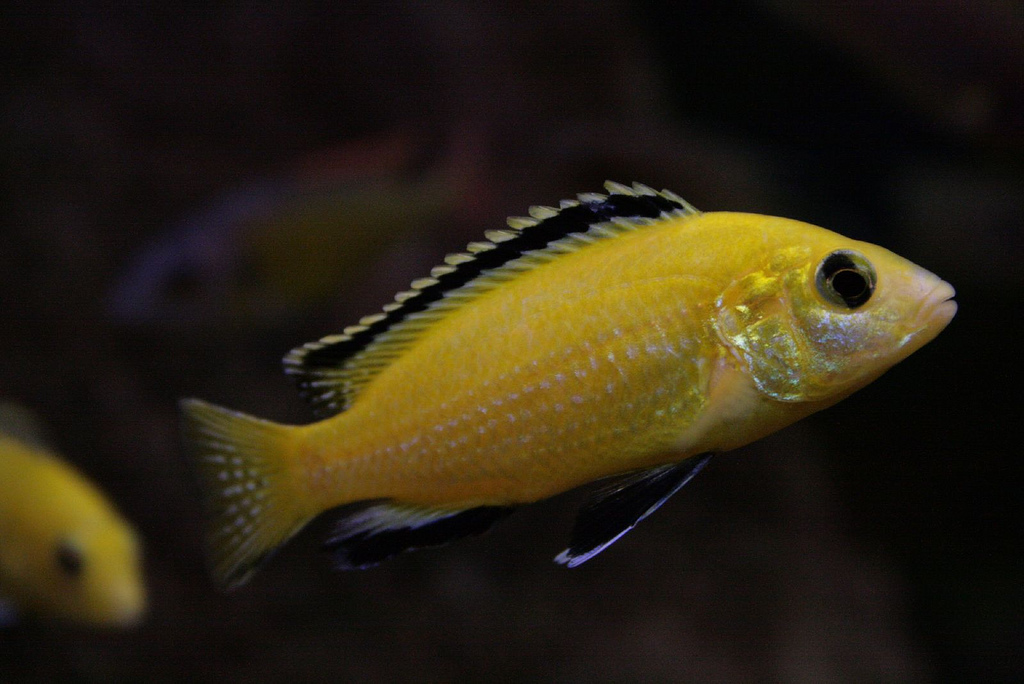
| Common/Market Names | Electric Yellow Cichlid, Lemon Yellow Lab |
| Price Range | $8 – $15 |
| Care Level | Easy |
| Behavior | Peaceful, active |
| Life Span | 6 – 10 years |
| Max Size | 4 inches |
The Yellow Lab Cichlid is an excellent tank mate for the Blue Dolphin Cichlid due to its peaceful nature and similar size. With its vibrant yellow coloration, this cichlid adds a striking contrast to the blue hues of the Blue Dolphin Cichlid. Both species share similar water parameters and dietary requirements, making them compatible in a community tank setting.
2. Peacock Cichlid (Aulonocara sp.)
| Common/Market Names | Aulonocara, Peacocks |
| Price Range | $15 – $30 |
| Care Level | Moderate |
| Behavior | Peaceful, shy |
| Life Span | 6 – 8 years |
| Max Size | 6 inches |
Peacock Cichlids are known for their stunning coloration and peaceful temperament, making them an ideal tank mate for the Blue Dolphin Cichlid. With various species available, such as the Sunshine Peacock or the Red Shoulder Peacock, these cichlids add visual interest to the aquarium while coexisting harmoniously with the Blue Dolphin Cichlid.
3. Bristlenose Pleco (Ancistrus sp.)
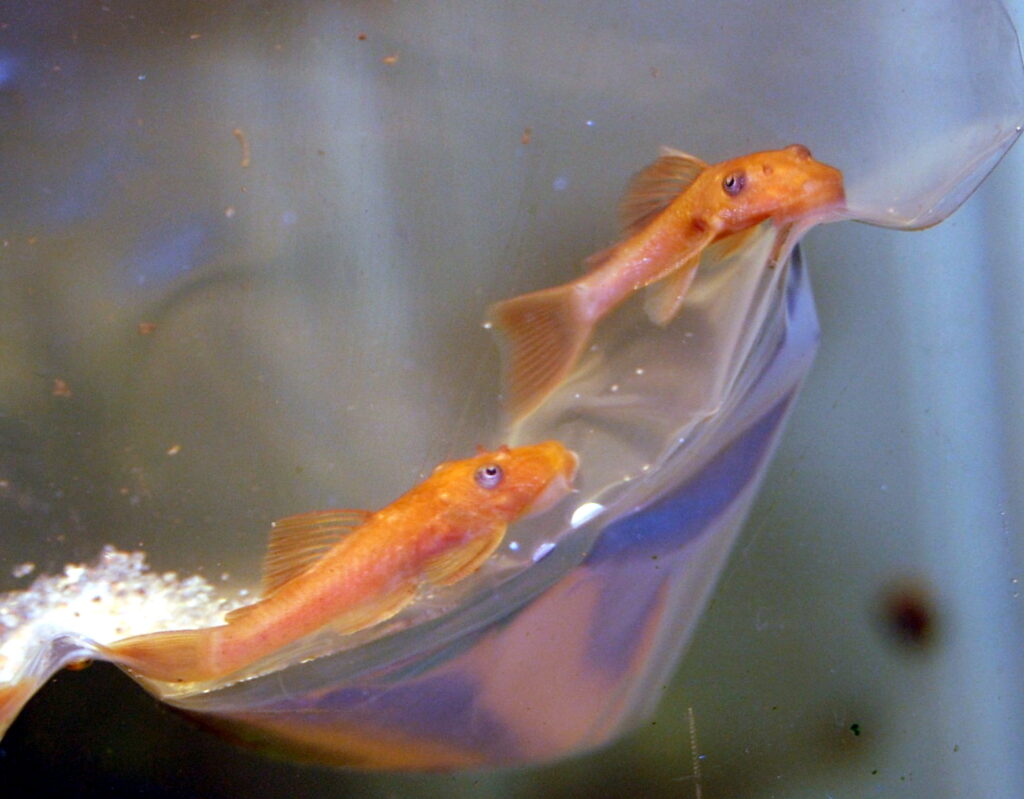
| Common/Market Names | Bushynose Pleco, Brushmouth Pleco |
| Price Range | $5 – $10 |
| Care Level | Easy |
| Behavior | Peaceful, nocturnal |
| Life Span | 5 – 7 years |
| Max Size | 5 inches |
The Bristlenose Pleco is a popular choice for community tanks, serving as an efficient algae eater and helping to maintain a clean aquarium environment. With its unique appearance characterized by bristle-like appendages on its nose, this peaceful and nocturnal fish is an excellent addition to a Blue Dolphin Cichlid tank.
4. Synodontis Catfish (Synodontis sp.)
| Common/Market Names | Upside-down Catfish, Squeaker Catfish |
| Price Range | $10 – $20 |
| Care Level | Easy |
| Behavior | Peaceful, nocturnal |
| Life Span | 5 – 7 years |
| Max Size | 4 – 6 inches |
Synodontis Catfish, particularly the Upside-down Catfish, are fascinating tank mates for the Blue Dolphin Cichlid. These peaceful and nocturnal catfish are known for their unique behavior of swimming upside-down, adding an interesting element to the aquarium. They are compatible with the Blue Dolphin Cichlid in terms of water parameters and temperament.
5. Giant Danio (Devario aequipinnatus)
| Common/Market Names | Tiger Danio, Malayan Danio |
| Price Range | $5 – $10 |
| Care Level | Easy |
| Behavior | Peaceful, active |
| Life Span | 3 – 5 years |
| Max Size | 4 inches |
Giant Danios are active and peaceful schooling fish that make excellent tank mates for the Blue Dolphin Cichlid. With their elongated bodies and striking coloration, these danios add movement and visual interest to the upper levels of the aquarium. They are hardy fish that can adapt to a wide range of water conditions.
6. Rainbow Shark (Epalzeorhynchos frenatum)
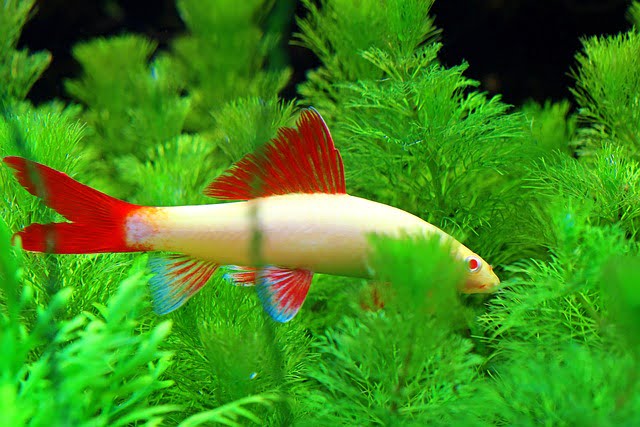
| Common/Market Names | Red-finned Shark, Ruby Shark |
| Price Range | $5 – $10 |
| Care Level | Moderate |
| Behavior | Semi-aggressive, territorial |
| Life Span | 5 – 8 years |
| Max Size | 6 inches |
The Rainbow Shark is a striking fish with a dark body and vibrant red fins, making it a visually appealing tank mate for the Blue Dolphin Cichlid. While they can be territorial towards their own species, they generally coexist peacefully with other fish. However, it is essential to provide ample space and hiding spots to minimize potential aggression.
7. Red Tail Shark (Epalzeorhynchos bicolor)
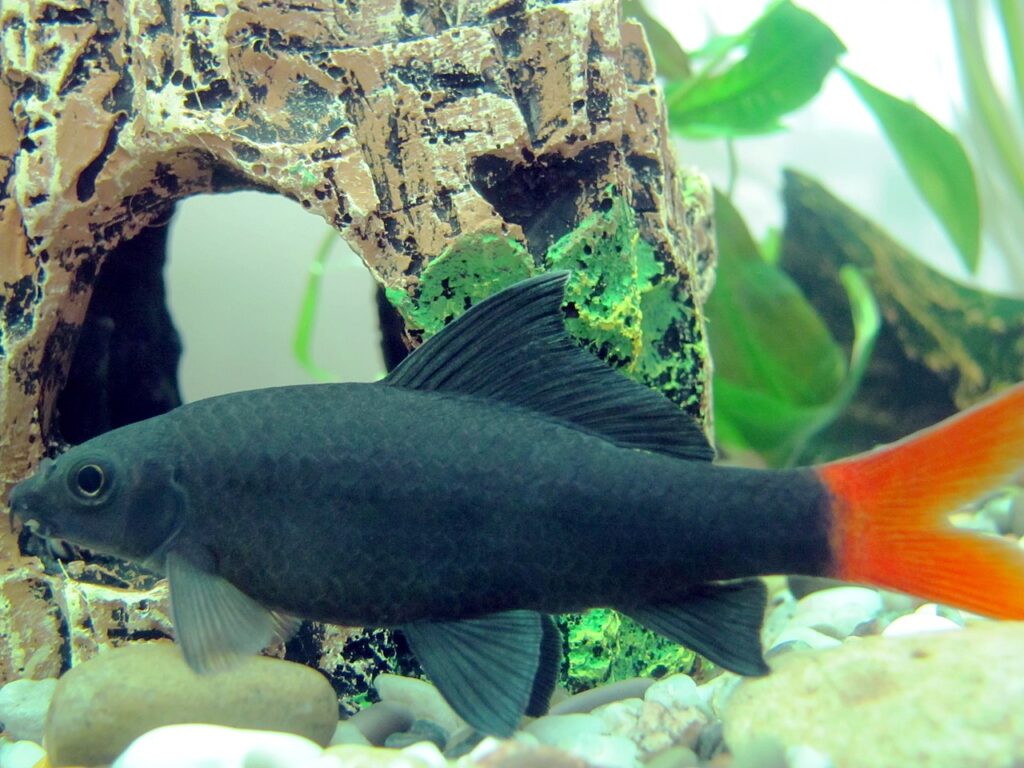
| Common/Market Names | Red-tailed Black Shark, Redtail Shark |
| Price Range | $5 – $10 |
| Care Level | Moderate |
| Behavior | Semi-aggressive, territorial |
| Life Span | 5 – 8 years |
| Max Size | 4 – 6 inches |
The Red Tail Shark is another visually striking fish that can be a compatible tank mate for the Blue Dolphin Cichlid. With its jet-black body and vibrant red tail, this fish adds a bold contrast to the aquarium. Like the Rainbow Shark, it can be territorial, so providing adequate space and hiding spots is crucial.
8. Clown Loach (Chromobotia macracanthus)
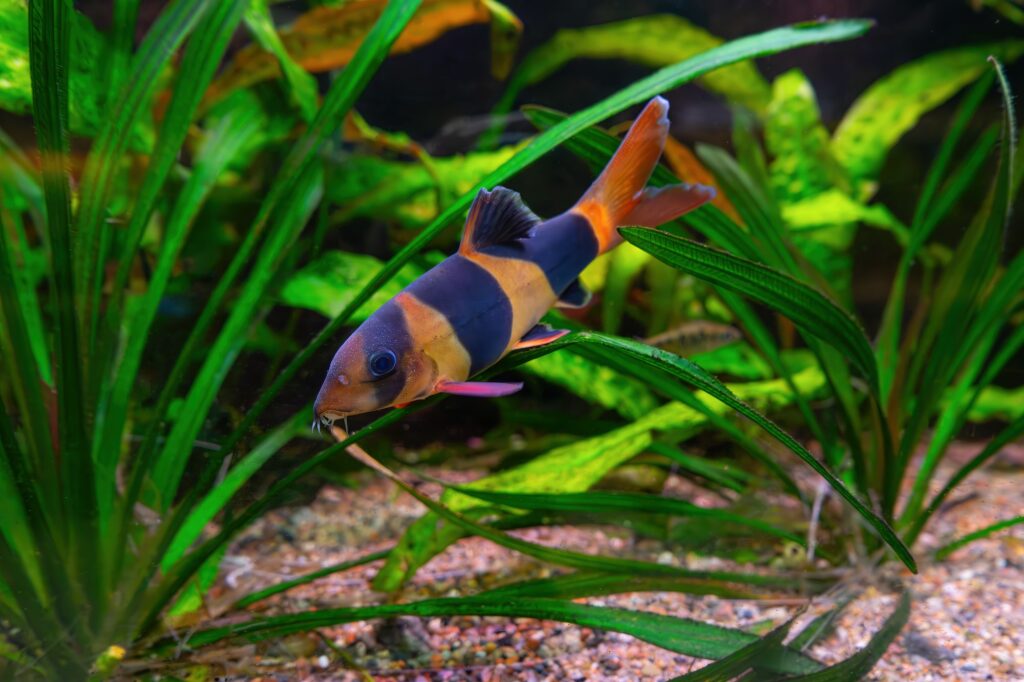
| Common/Market Names | Tiger Botia, Clown Botia |
| Price Range | $10 – $20 |
| Care Level | Moderate |
| Behavior | Peaceful, sociable |
| Life Span | 10 – 15 years |
| Max Size | 12 inches |
Clown Loaches are peaceful and sociable fish that make excellent tank mates for the Blue Dolphin Cichlid. With their distinctive orange and black stripes, these loaches add a playful and lively presence to the aquarium. They are known for their gregarious nature and prefer to be kept in groups of three or more.
9. Kribensis Cichlid (Pelvicachromis pulcher)
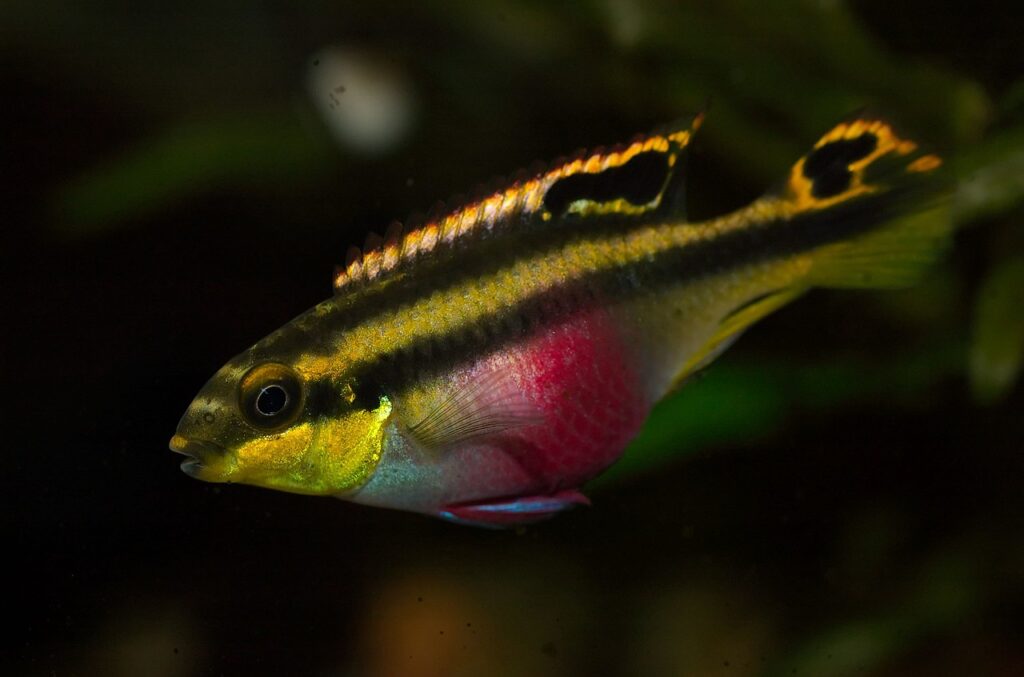
| Common/Market Names | Krib, Rainbow Krib |
| Price Range | $5 – $10 |
| Care Level | Easy |
| Behavior | Peaceful, can be territorial when breeding |
| Life Span | 3 – 5 years |
| Max Size | 4 inches |
Kribensis Cichlids are colorful and peaceful fish that can coexist well with the Blue Dolphin Cichlid. These West African cichlids display an array of vibrant colors, with males being more brightly colored than females. They are generally peaceful but can become territorial during breeding, so providing hiding spots and caves is essential.
10. Synodontis Multipunctatus (Synodontis multipunctatus)
| Common/Market Names | Cuckoo Catfish, Cuckoo Squeaker |
| Price Range | $15 – $25 |
| Care Level | Moderate |
| Behavior | Peaceful, can be shy |
| Life Span | 5 – 7 years |
| Max Size | 6 inches |
Synodontis Multipunctatus, also known as the Cuckoo Catfish, is a unique and peaceful tank mate for the Blue Dolphin Cichlid. With its spotted pattern and whiskery appearance, this catfish adds visual interest to the bottom levels of the aquarium. They are known for their fascinating breeding behavior, where they lay their eggs in the nests of mouthbrooding cichlids.
FAQs
Aquarists frequently encounter numerous inquiries when it comes to the maintenance of Blue Dolphin Cichlids. These queries delve beyond the fundamental aspects of care and tank prerequisites. These questions can delve into the nuances of keeping this particular species healthy, happy, and thriving. To help you better understand the intricacies of caring for Blue Dolphin Cichlids, here are some frequently asked questions that haven’t been covered in previous discussions.
How Do Blue Dolphin Cichlids Interact with Plants in the Aquarium?
Blue Dolphin Cichlids are generally not plant destroyers, but they do like to dig. Therefore, it’s advisable to secure plants well or opt for hardy varieties that can withstand some disturbance.
Can Blue Dolphin Cichlids Be Kept in a Planted Tank?
Yes, they can be kept in a planted tank, but choose hardy plants that can tolerate the cichlid’s tendency to dig and rearrange the substrate.
What Are the Signs of Stress in Blue Dolphin Cichlids?
Signs of stress can include faded coloration, reduced activity, and a lack of interest in food. Stress can be caused by various factors such as poor water quality, incompatible tank mates, or illness.
Do Blue Dolphin Cichlids Need a Lot of Swimming Space?
Yes, these fish are active swimmers and enjoy having plenty of room to move around. A cramped tank can lead to stress and health issues.
How Do You Differentiate Between a Juvenile and Adult Blue Dolphin Cichlid?
Juveniles generally have less pronounced humps on their heads and less vibrant coloration. As they mature, the hump becomes more prominent, and their colors intensify.
Can Blue Dolphin Cichlids Live with Invertebrates?
It’s generally not recommended to keep them with invertebrates like shrimp or snails, as they may see them as food.
Do Blue Dolphin Cichlids Make Sounds?
While it’s not common knowledge, some aquarists have reported hearing clicking sounds from their cichlids, especially during feeding or territorial disputes.
How Often Should You Change the Water for Blue Dolphin Cichlids?
A bi-weekly water change of about 20-30% is generally recommended to maintain optimal water quality.
Can Blue Dolphin Cichlids Be Kept with Saltwater Fish?
No, Blue Dolphin Cichlids are freshwater fish and should not be kept in a saltwater environment.
What Type of Lighting is Best for Blue Dolphin Cichlids?
Moderate lighting is ideal, as too much light can cause stress, and too little can affect their natural behavior and coloration.
Is It Necessary to Use Air Stones or Oxygenators for Blue Dolphin Cichlids?
While Blue Dolphin Cichlids are not overly sensitive to oxygen levels, using an air stone or oxygenator can help improve water circulation and oxygenation, which is beneficial for the overall health of the tank.
How Do Blue Dolphin Cichlids React to Seasonal Changes?
In their natural habitat, these cichlids experience seasonal changes that can affect their behavior. In a home aquarium, maintaining a consistent environment is generally best, but some aquarists simulate seasonal changes to encourage natural behaviors like breeding.
Can Blue Dolphin Cichlids Be Trained?
While they’re not known for their trainability, Blue Dolphin Cichlids are intelligent and can recognize their owners. Some aquarists have had success with simple training exercises like hand-feeding.
What Type of Substrate is Best for Blue Dolphin Cichlids?
A sandy substrate is often recommended as it allows the fish to engage in their natural digging behaviors without harming themselves, as could happen with a gravel substrate.
Are Blue Dolphin Cichlids Sensitive to Medication?
Like many cichlids, they can be sensitive to certain medications, especially those containing copper. Always consult with a veterinarian or experienced aquarist before administering any medication.
How Do Blue Dolphin Cichlids Handle Transportation?
They are relatively hardy but can be stressed by poor transportation conditions. It’s crucial to ensure that they are transported carefully, ideally over short distances.
Is It Possible for Blue Dolphin Cichlids to Jump Out of the Tank?
While not known for jumping, it’s always a good idea to have a secure lid on your aquarium to prevent any accidental escapes, especially when the fish are startled or stressed.
Can You Keep Multiple Males in the Same Tank?
It’s possible but not recommended unless the tank is large enough to establish separate territories. Multiple males in a confined space can lead to aggressive behaviors and stress.
Do Blue Dolphin Cichlids Change Color?
Yes, their color can change depending on their mood, health, and during breeding seasons. A sudden change in color, however, could be a sign of stress or illness.